
Rediscovering Japan

Rediscovering Japan
Travel (Hiroshima Prefecture (Mihara/Takehara/Higashihiroshima))

by tomizuta
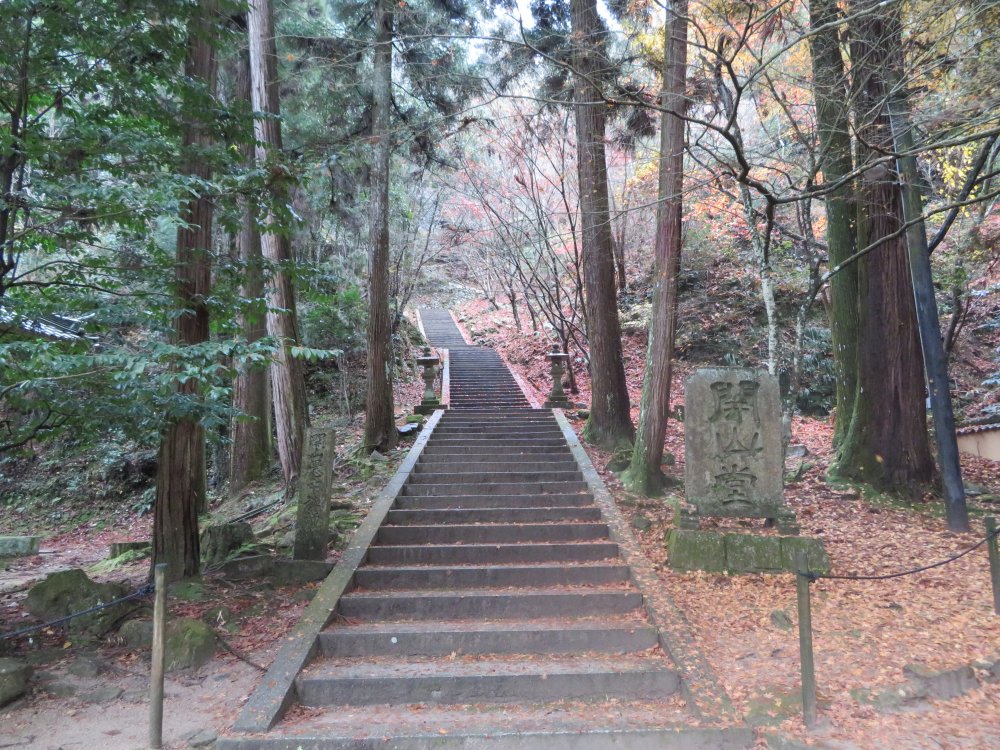
The steps leading up to the Jizoudou, the oldest building of Buttsuuji founded at the end of the 14th century. I could easily see why this location was selected for zen meditation. Mihara City has many Buddhist temples the majority of which are zen temples.
I’d been to the cities of Takehara and Mihara, but had not really studied seriously, so in December 2018, taking the opportunity of visiting a relative in Hiroshima City, we set out to rediscover the cities in more detail. We left Hiroshima City in the morning and first drove east for about seventy kilometers to central Mihara. I did not know until this visit that both Mihara and Takehara were once castle towns under the rule of the Kobayakawa Family.
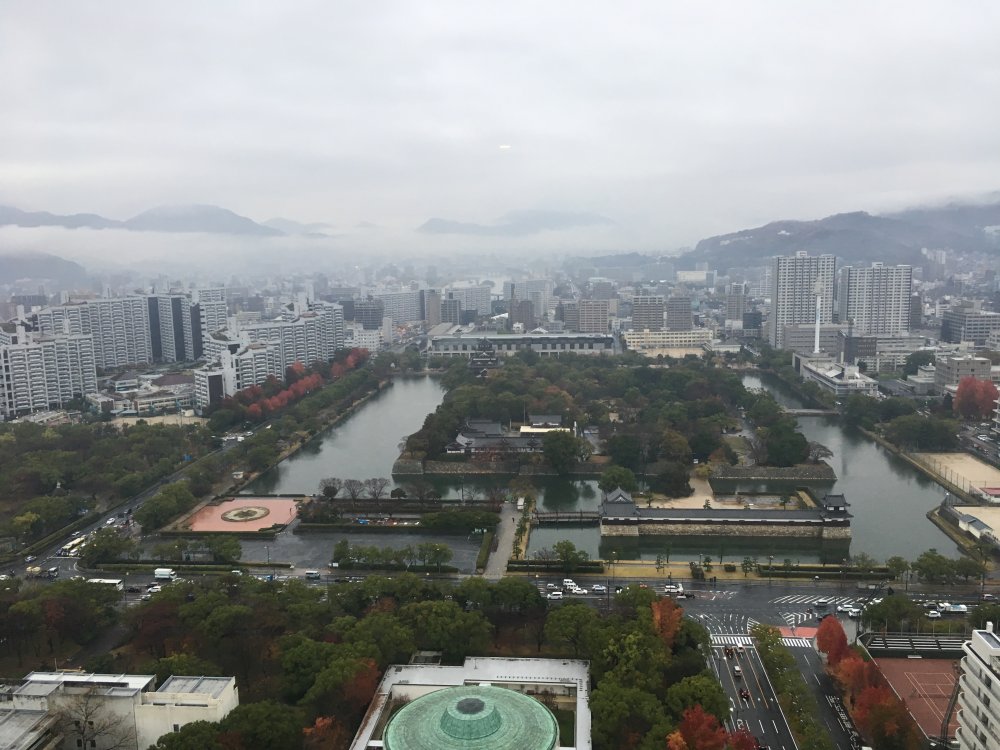
View of Hiroshima Castle from our hotel. We left Hiroshima early morning and drove east to Mihara City.
As usual, we made a brief visit to Mihara History Museum next to the City Library, located south of Central Mihara across River Nishino. The main river flowing through Mihara is River Nuta (the kanji characters could be read Numata, but the true name is Nuta). It was a Monday morning and there seemed to be very few visitors except us if any. The curator approached us and told us to catch him should we have any questions. Admission is free and we were provided with some brochures. The museum tells a lot from archaeological times to modern, but the main focus appears to be the now lost castle. The displays and explanation of the castle is quite extensive. A free brochure is provided for major displays, over forty in total. There were probably a dozen just talking about the castle foundation. For non-scholars and overseas visitors, just browsing through the museum to gather an understanding through pictures of how grand the castle once was and how Mihara developed in modern times would be best.
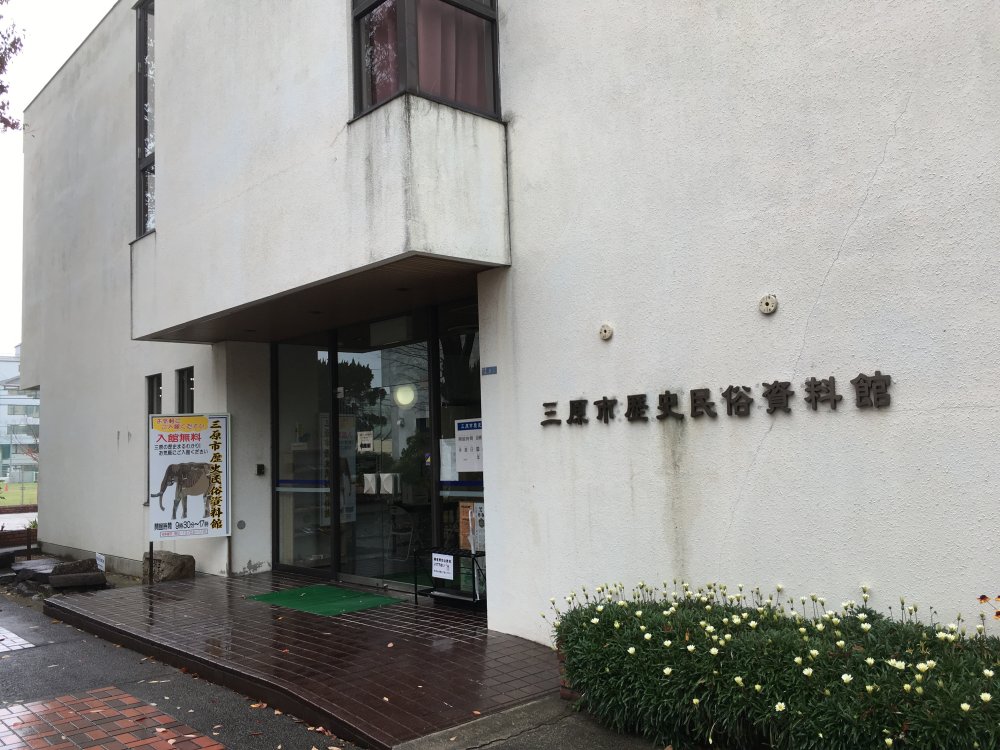
The Mihara City History Museum next to the City Library. Admission is free.
We next visited the ruins of Mihara Castle. It is quite unique, but Mihara Station was opened in the late 19th century on where the main castle and the keep once stood. Very little of the castle ruins remain to this day except for some stone foundations and walls as well as some gates relocated to local temples. You can visit the foundation of the castle keep remains from the second floor of JR Mihara Station, which is also a Sanyo Shinkansen stop.
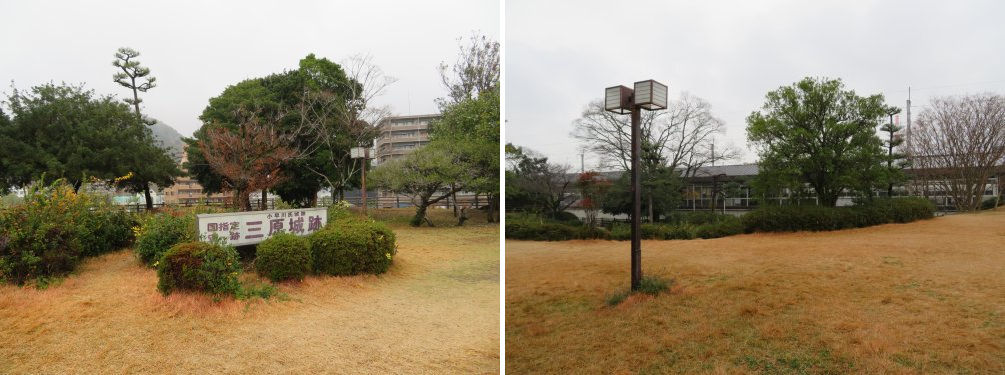
Looking north from Mihara Castle ruins (left) and south. The station platform can be seen in the back (right).
Mihara Castle was first constructed by Takakage Kobayakawa in 1567 in Japan’s
civil war period that was put to an end in 1590 by Hideyoshi Toyotomi.
Here I need to pause and talk a bit about Takakage Kobayakawa. The area
of Takehara and Mihara was historically governed by the Kobayakawa Family,
descendants of a subordinate of Yoritomo Minamoto (the founder of the Kamakura
Government in the late 12th century) who was given this land as a reward
of his contribution to the war against the Heiji clan. Eventually, Mihara
became to be governed by the Nuta Kobayakawa Family and Takehara by the
Takehara Kobayakawa Family stemming from the main family in Mihara. Takakage
was born as the third son of Motonari Mouri and was adopted by the Takehara
Kobayakawa in 1544. Following a family feud of Nuta Kobayakawa, Takakage
united the two families and moved to Mihara around 1550. Takakage never
lost his loyalty to the Mouri Family, but recognizing Hideyoshi’s power,
became one of Hideyoshi’s five senior cabinet members. He resisted being
rewarded to become a feudal lord and retired to Mihara Castle until he
died in 1597. After Takakage, Mihara Castle came under control by the Mouri
Family, Masayuki Fukushima of Hiroshima, Tokugawa direct control, until
it became a sub-castle of the Asano Family of Hiroshima through the Edo
era. I guess that is why Mihara City remembers Takakage as the founder
of Mihara and celebrated the 450th year since the construction of Mihara
Castle in 2017. We left the castle ruins to visit the castle park on the
west side of the moat. From there you can get a good view of the castle
keep ruins.
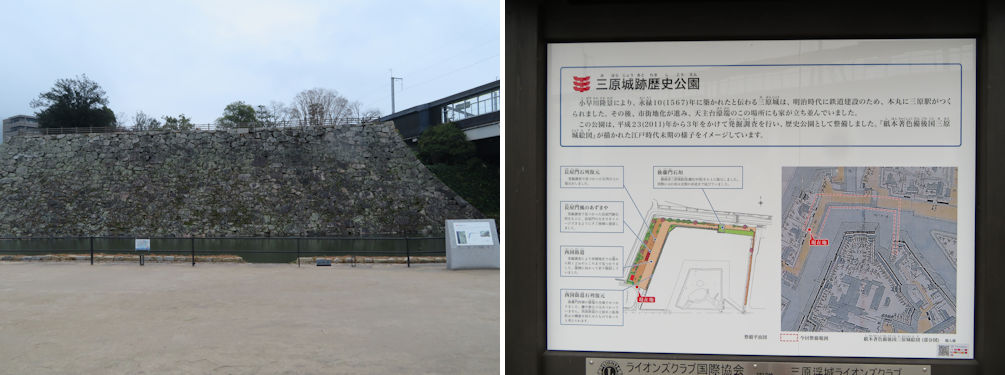
The view of the stone foundation and castle keep from the Castle Park on the west (left). The explanation tells us where the park is located against a map from the Edo period (right).
Mihara is known for its octopus and a favorite dish is takomeshi (rice and octopus steamed with dashi seasoning). We searched the city center from the station to the waterfront. It appeared that there are very few local cuisine restaurants open for lunch on a Monday, but we finally came across one tucked in a back alley. We sat at the counter and ordered the takomeshi lunch (2,000 yen) and the sashimi lunch (1,800 yen). The sashimi was very fresh and certainly met my expectation. The takomeshi was also very good and recommendable.
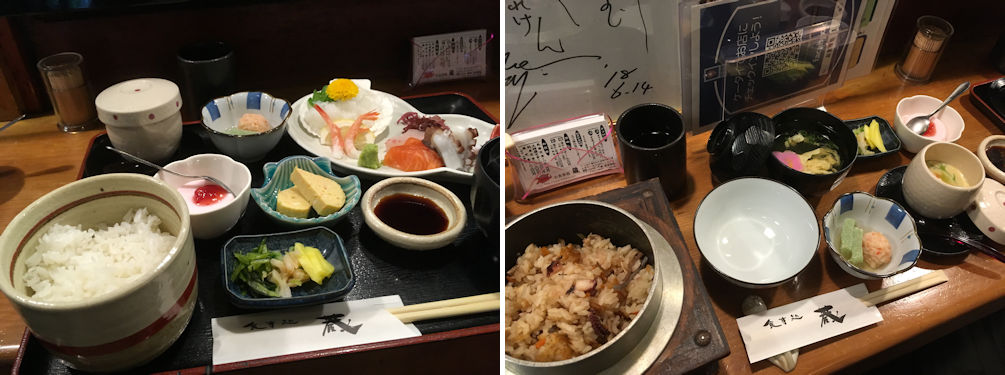
The sashimi lunch course (left) and the takomeshi lunch course (right). Octopus is a popular feature in Mihara City.
Since we had some time before checking in at the ryokan in Mihara City, we made a brief visit to Saijou in Higashihiroshima City which is famous as a sake brewing town. I hadn’t visited Saijou in many years, but it appeared that the town center had undergone quite a lot of development. We parked our car in a car park about three hundred meters south of JR Saijou Station. It appeared that a sake festival had just ended on Sunday.
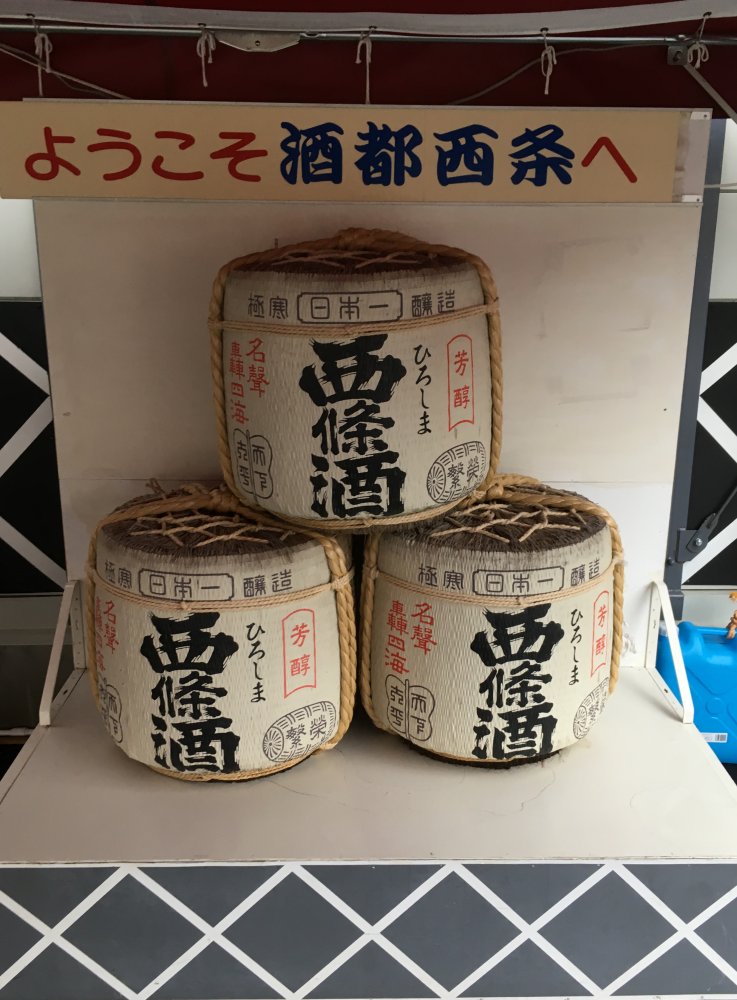
This display was left over from the sake festival. It welcomes us to Saijou, the sake brewing town, with three sake barrels labeled Saijoushu (Saijou sake). I don't know if a pun was intended but Saijoushu can also mean "the very best sake".
From there we went to explore the sake brewing area in between called Sakagura-doori Street. I was happy to see that Sakagura-doori Street hadn’t changed much. Saijou Honmachi History Square, introducing the history of sake brewing in the area had been newly opened in spring 2018. I learned that until the end of the Edo era, this area was a relatively large lodging village called Saijou Yokkaichi on the Saigokukaidou route linking Kyoto with Shimonoseki in Yamaguchi Prefecture, Yokkaichi meaning a market was held on the 4th, 14th and 24th days of every month. I was surprised to learn that of the seven sake breweries in Saijou, with the exception of Hakubotan founded in 1675, all breweries only started after the Meiji Restoration.
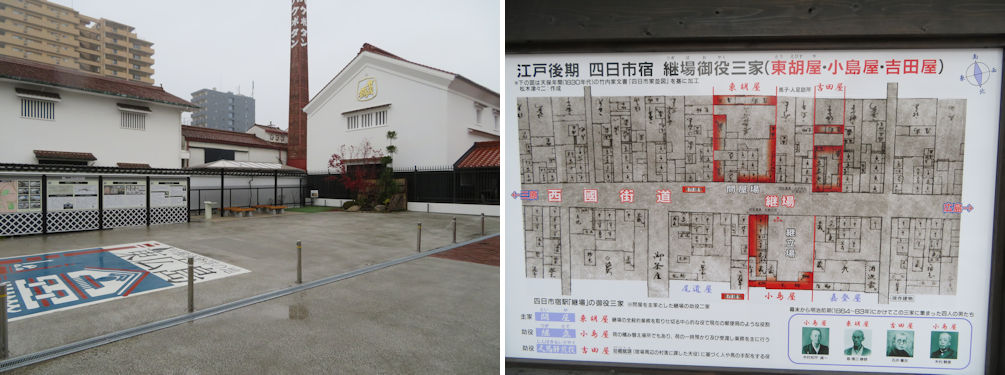
The Saijou Honmachi History Square tells us about the history and people that contributed to sake brewing in Saijou (left). The old map shows the rows of lodging and and the three main houses that had functions of a post office, goods handling and procurement of fresh horses in Saijouyokkaichi in the Edo era (right).
We went into Saijoutsuru Brewery which started in the Edo area. I chatted with the staff who admitted that a lot of development had occurred in Saijou. I bought a 720 milliliter bottle of their junmai sake, which I found very drinkable.
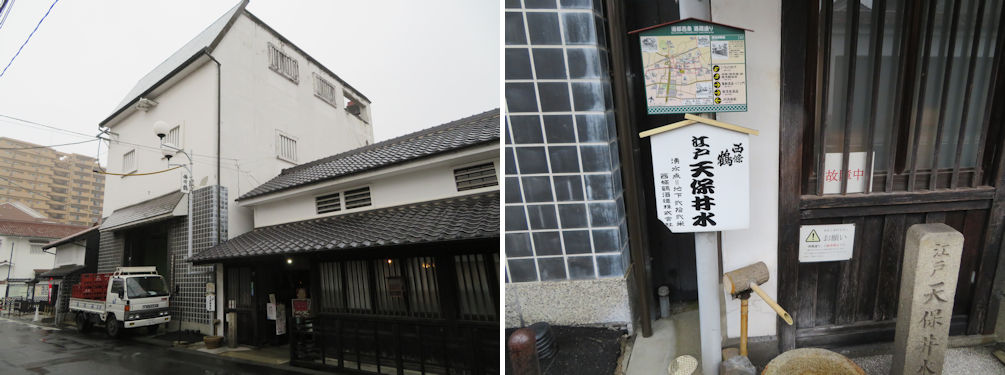
Saijoutsuru established in 1904 continues to brew sake from local rice and quality water from its well (left). The Edo Tenpou well water. Tenpou is a period around 1830. You can enjoy a free drink of this water from twenty two meters underground (right).
We had a full day left next day before our evening flight from Hiroshima Airport in north Mihara. We first visited Takehara. I had visited Takehara before but that was before I started my quest to rediscover Japan. My previous visits had been to view the are designated as an Important Preservation District for Groups of Historic Buildings. The main feature of this area is the grand residences of the salt producers. I understand that at the end of the Edo period Takehara was one of the largest salt producing areas of Japan. But it was not until this visit that I found that Takehara was once ruled by Takakage Kobayakawa and was a castle town as well. The castle that Takakage entered when he was adopted by the Kobayakawa Family was Kimura Castle which was located in the mountains about five kilometers north of central Takehara.
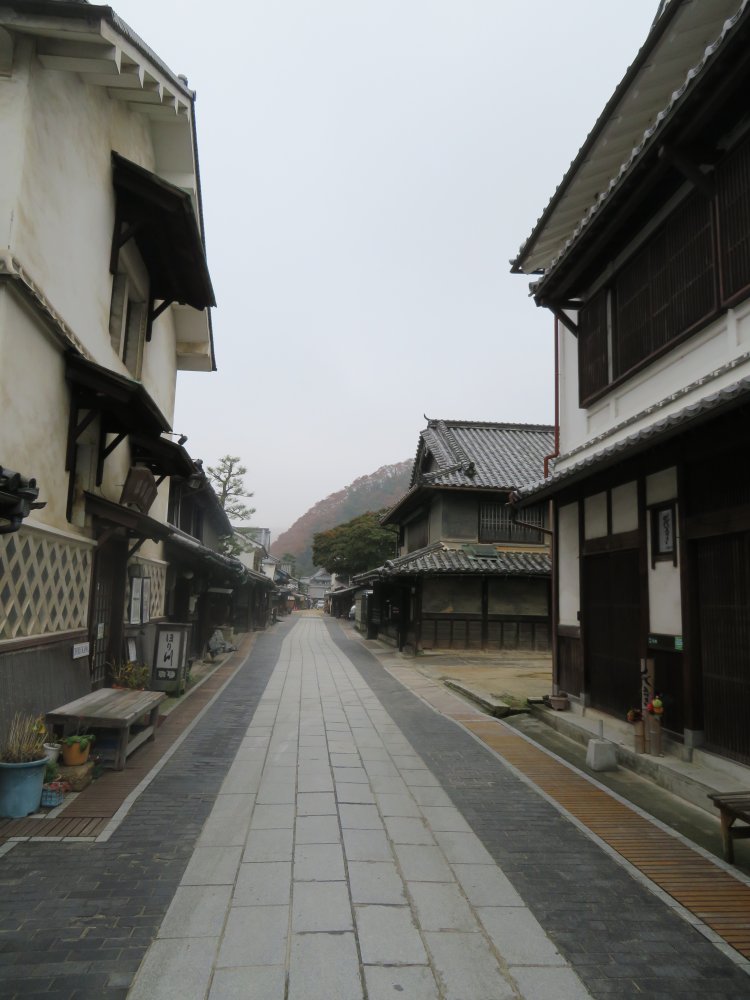
The high street of old Takehara designated as an Important Preservation District for Groups of Historic Buildings.
Salt producing in Takehara started in the middle of the 17th century. It peaked in the 18th century from when it declined due to competition and over production. Towards the end of the Edo era, some mass producers emerged in the decline, whose grand residences are the star features of the historic buildings. Some of these successful merchants went into sake brewing and shipping as well. We first viewed Sumiyoshi Shinto Shrine invited from Sumiyoshi-taisha in Osaka, to wish for the prosperity of Takehara. In the old days the shrine must have stood at the waterfront where people prayed for safety at sea. A festival is held every year from late July to early August.
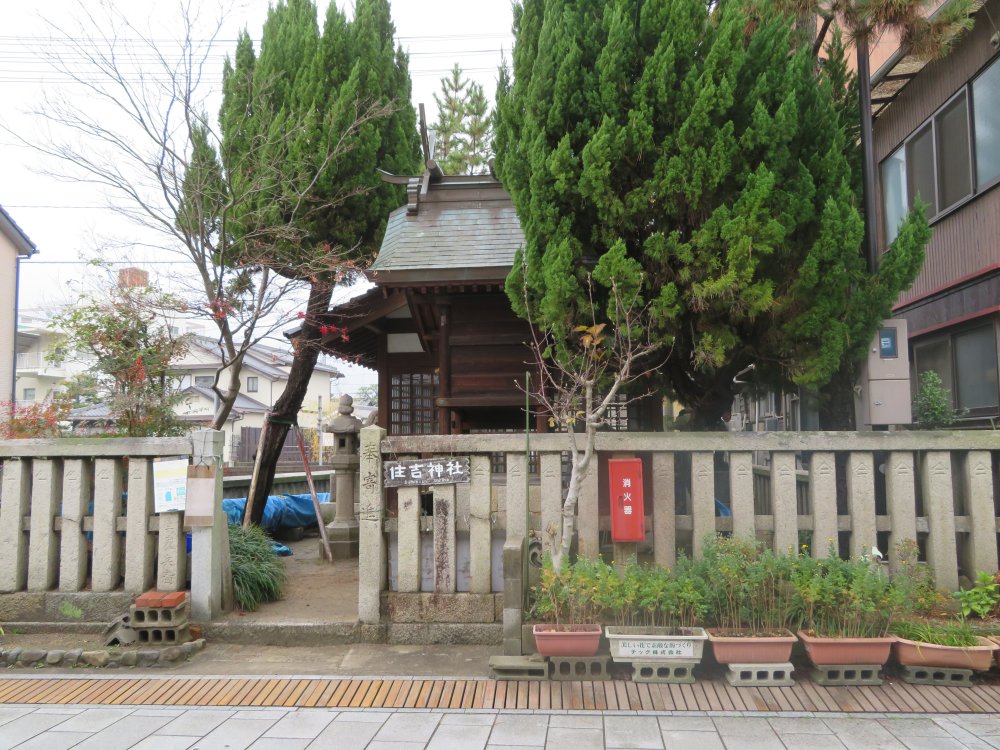
We first viewed Sumiyoshi Shinto Shrine invited from Sumiyoshi-taisha in Osaka, to wish for the prosperity of Takehara.
We then went to visit the former Matsuzaka Family Residence. There were two people sweeping the garden and we asked one lady to accept entry. She apologized for not being at the admission office, but told us that the place had just reopened after being closed for two weeks for film shooting. We thought of buying a combined ticket that allows entry to the residences of Matsuzaka, Mitsumoto and Morikawa as well as the history museum for 600 yen. However, we were advised that getting discounts for JAF (Japan Automobile Federation) was a better deal. The Matsuzaka Family sold coal and firewood and had salt making and sake brewing businesses. This residence was built in the early 19th century and refurbished in 1879 according to their brochure. From there we went up the high street. Unfortunately, the history museum was closed on Tuesdays.
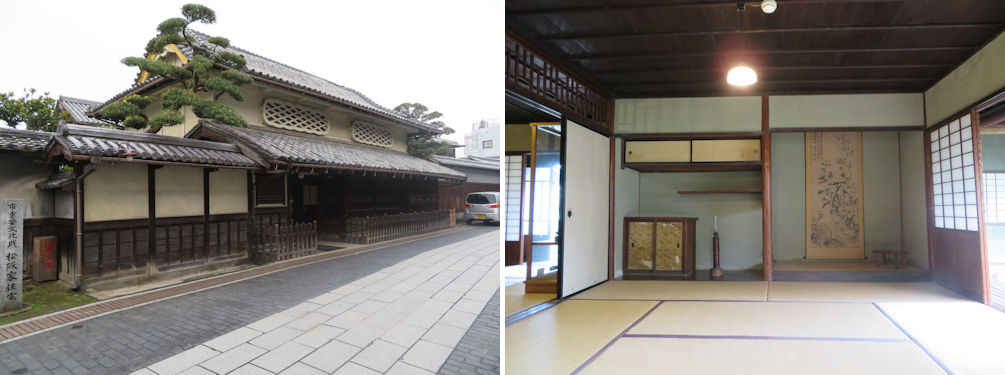
The outside of the Matsuzaka residence facing high street (left) and the spacious reception room where guests would have been received (right).
From the high street, we went up the stairs to Saihouji Temple. Saihouji is a former zen sect temple converted to the Joudo sect in the Edo period. The main temple building was refurbished in the early 18th century. What is unmissable is the platform called Fumeikaku built in 1758, from where you can command a spectacular view of Takehara, and which has been a favorite film shooting spot.
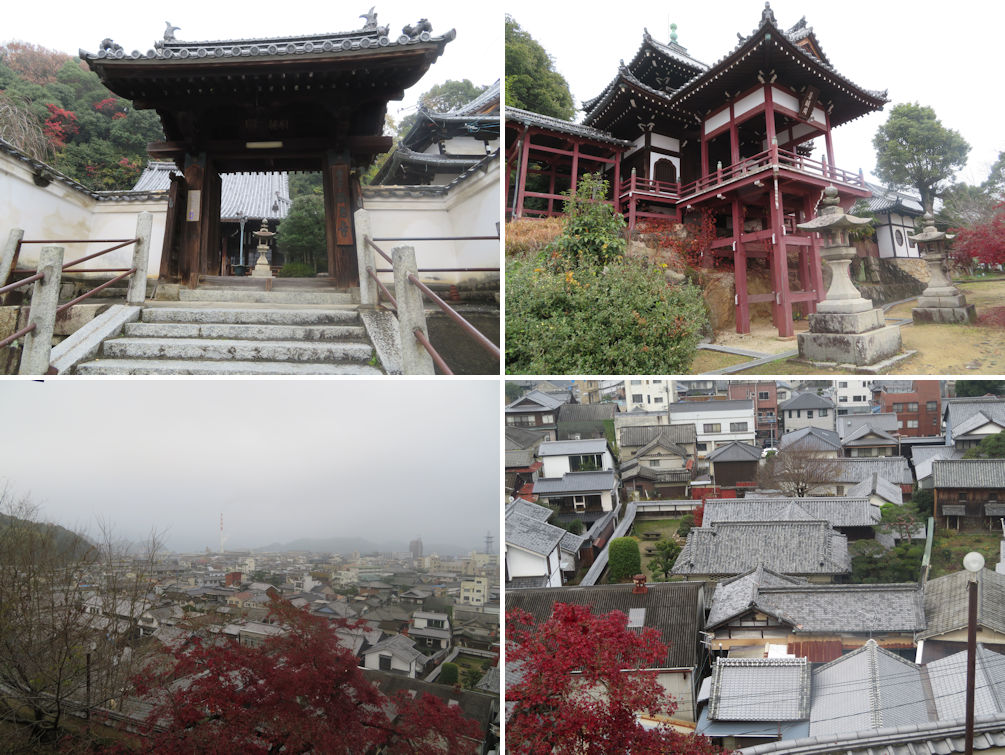
The sanmon gate of Saihouji (upper left), Fumeikaku and its platform (upper right), view of the sea from Fumeikaku (lower left) and view of the area of historical buildings. The Matsuzaka Residence is in the middle (lower right).
The high street is most interesting to stroll with many shops, cafeterias, restaurants and sake breweries. We noticed that the northern part of high street was covered with sand. We learned that was for the film shooting to create an Edo scenery. Everybody cooperated by displaying ornaments from the Edo period in front of their houses. At the northern end of high street is Ebisudou. Ebisu is a deity worshipped by merchants to bring prosperity.
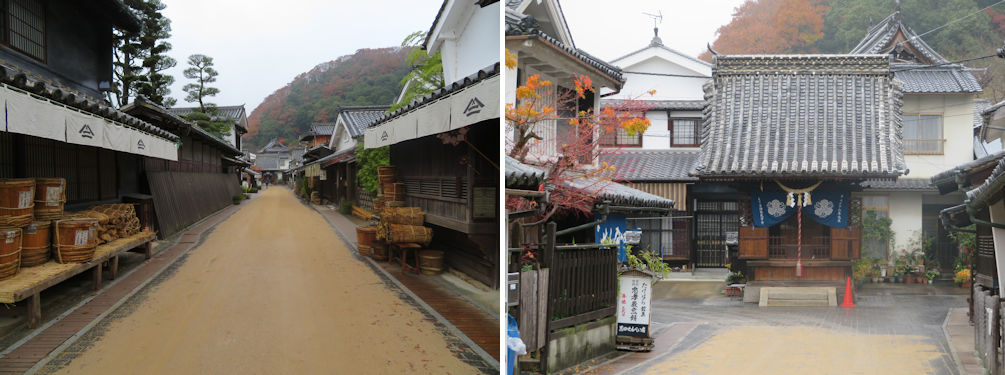
The northern part of high street was covered with sand. We learned that was for the film shooting to create an Edo scenery (left). At the northern end of high street is Ebisudou.
We turned left twice to come back by the back alley. We first paid a visit to Fujii sake brewery. The business was established in 1863 when salt producing in Takehara was the major industry. This is an interesting place as they have a large display of local craft in the sake shop and warehouse. They welcome visitors to try their sake. I would personally recommend their sake Houju, especially their tokubetsu (special) junmai.

We first paid a visit to Fujii sake brewery. This is an interesting place as they have a large display of local craft in the sake shop and warehouse.
A short walk brought us to the former Mitsumoto Family residence now owned by Takehara City. The building is a former annex building of a larger residence from the Edo area. The building is now under custody of Takehara City. The warehouse has now become a museum housing displays of a local potter.
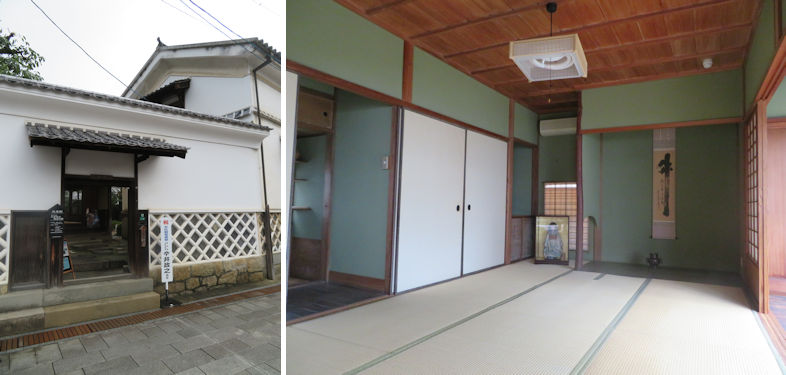
The entrance to the Mitsumoto residence (left) and the reception room inside (right).
Our last visit was to the former Morikawa Family Residence. I personally think this was the most rewarding of the visits to residences. The main building from the early Meiji era was relocated from the Fukuyama area and the tea room from within Takehara. It is quite relaxing to view the beautiful Japanese garden from the main building.
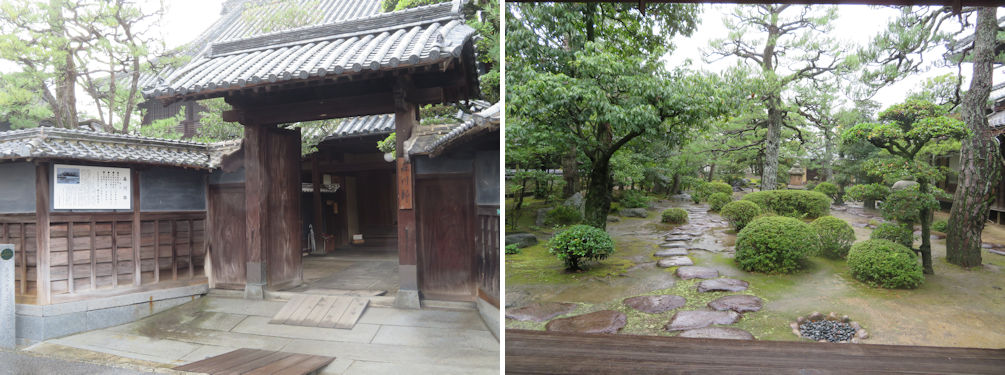
The entrance to the Morikawa residence (left) and the beautiful inside garden (right).
We left Takehara and headed to Mihara to visit Soukouji Buddhist Temple of the zen Soutou sect. There are numerous Buddhist temples scattered in Mihara of which a large majority are zen temples, demonstrating how highly the Kobayakawa Family took to zen Buddhism. Soukouji Temple was founded in 1577 under Takakage’s wish to mourn for his deceased Mouri parents. Castles in the civil war period were built on mountains, but moved to lower areas in the late 16th century as peace was gradually restored. Soukouji was initially situated in Niitakayama Castle on top of Mount Niitaka where Takakage resided until he retired and moved to Mihara Castle in 1596 at which point Soukouji was also relocated to the current site. Niitakayama Castle was dismantled. It was common when castles are abandoned for the foundation stones and gates to be reused. The foundation stones of Niitakayama Castle were reused at Mihara Castle. It was thought that the great Sanmon Gate of Soukouji was relocated from Niitakayama Castle, but the description by the gate says that it was likely newly built by the Fukushima Family of Hiroshima in the early 17th century. In any event, the Sanmon gate is one of the largest existing four pillar gates in Japan.
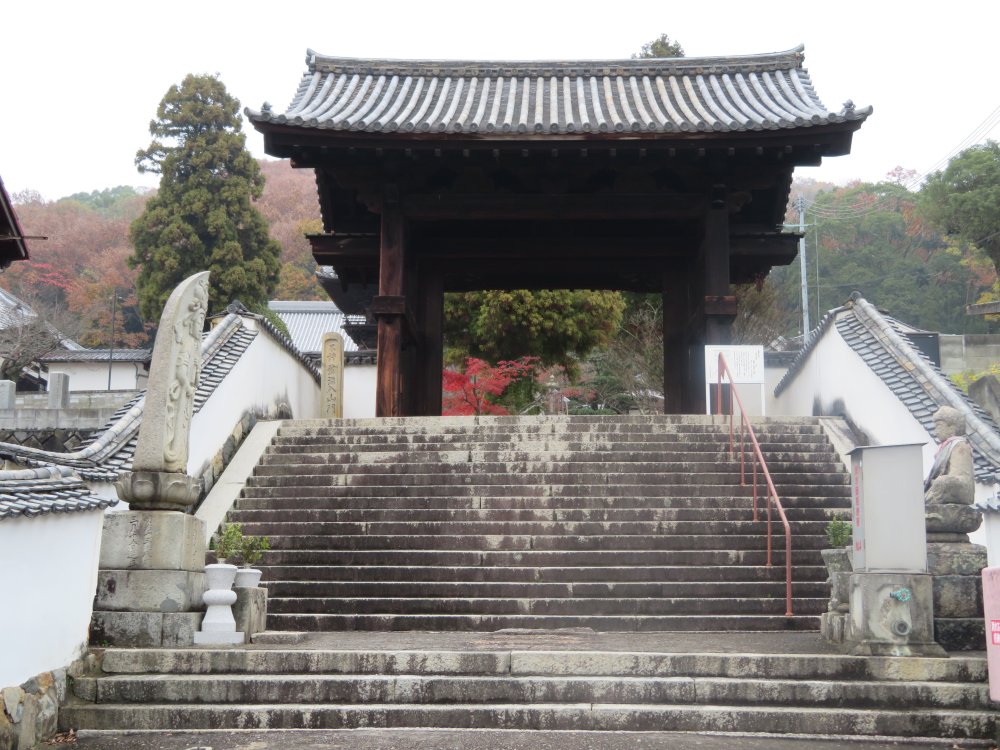
The grand sanmon gate of Soukouji Temple. It is one of the largest existing four pillar gates in Japan.
We went through the Sanmon Gate to reach the main temple area where there was a zen building annexed to the main temple (hondou) and bell tower.
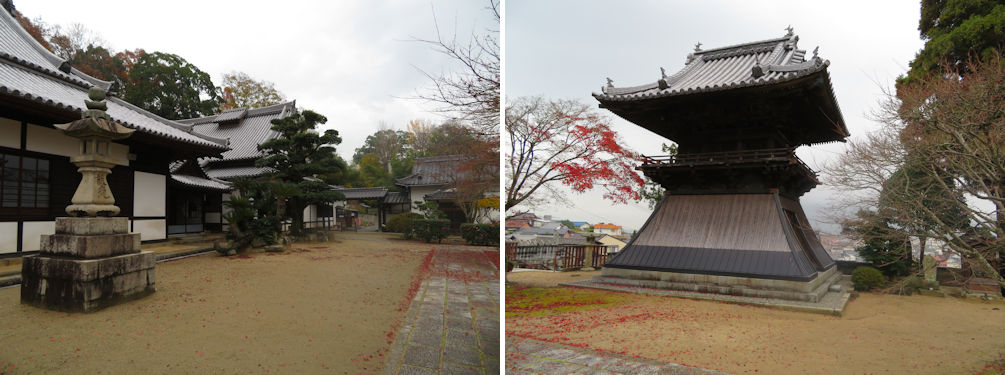
The main temple area (left) and the bell tower (right).
Our final place to visit was Buttsuuji Temple of the zen Rinzai sect. It is only less than fifteen kilometers north west of Mihara city center, but in a very remote area in the mountains. On the way, there were warnings that some roads were closed no doubt due to the flooding in July 2018. We had to make some detours but managed to reach the temple. We parked at the second car park where there is a bus stop (I understand that there are only two services a day). It is such a vast mountain forest area we were at a loss to find the temple buildings until we studied a layout map in the corner of the car park. It was early afternoon but we were the only visitors before another car came and an elderly couple got out. I understand that Buttsuuji is a popular place to view the Autumn coloring of the leaves, but it was hard to imagine how this could be with so few visitors.
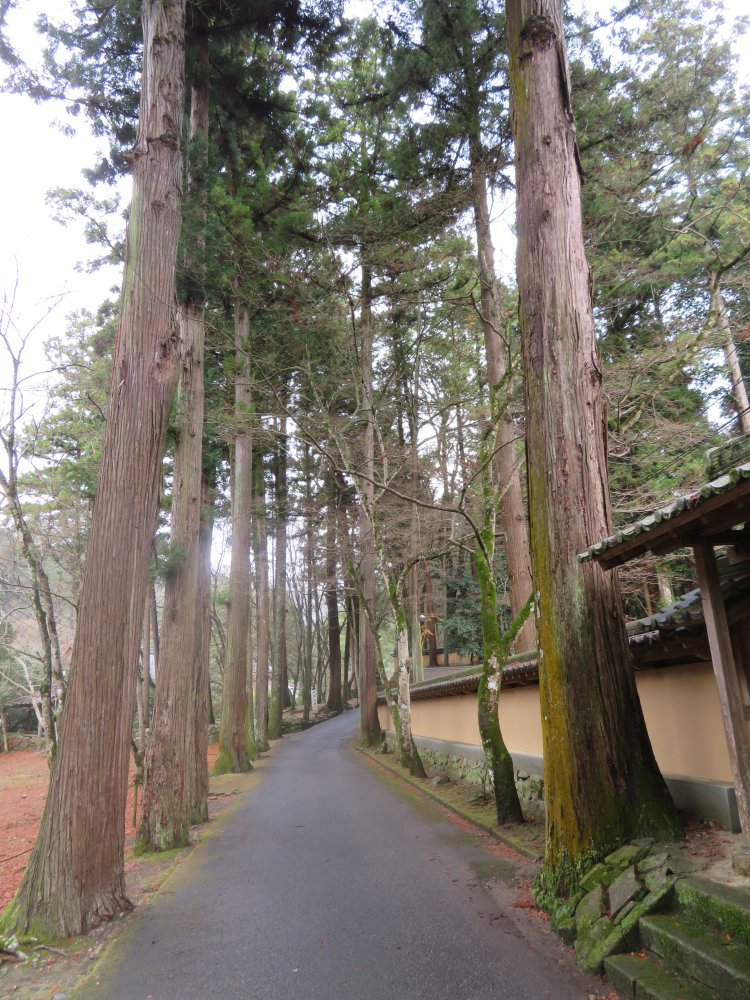
The path leading to the temple buildings. A river flows on the left.
Buttsuuji Temple was founded by the Kobayakawa Family by inviting a zen high priest from China at the end of the 14th century. It flourished under the patronage of the Kobayakawa as well as Mouri Families. It went into decline in the Edo era but regained prominence from the Meiji era. It is the largest zen meditation dojo in western Japan and offers group training for company employees. The serene and solemn setting certainly is ideal for a zen temple. It was a couple of minutes’ walk through the woods to reach the sanmon entry gate. It was apparent that the flooding in July had caused some damage to the river banks flowing through. We went through the sanmon gate to reach the main temple area. I understand the current gate was constructed at the end of the 18th century. There was a description by the gate that tells us the history of Buttsuuji.
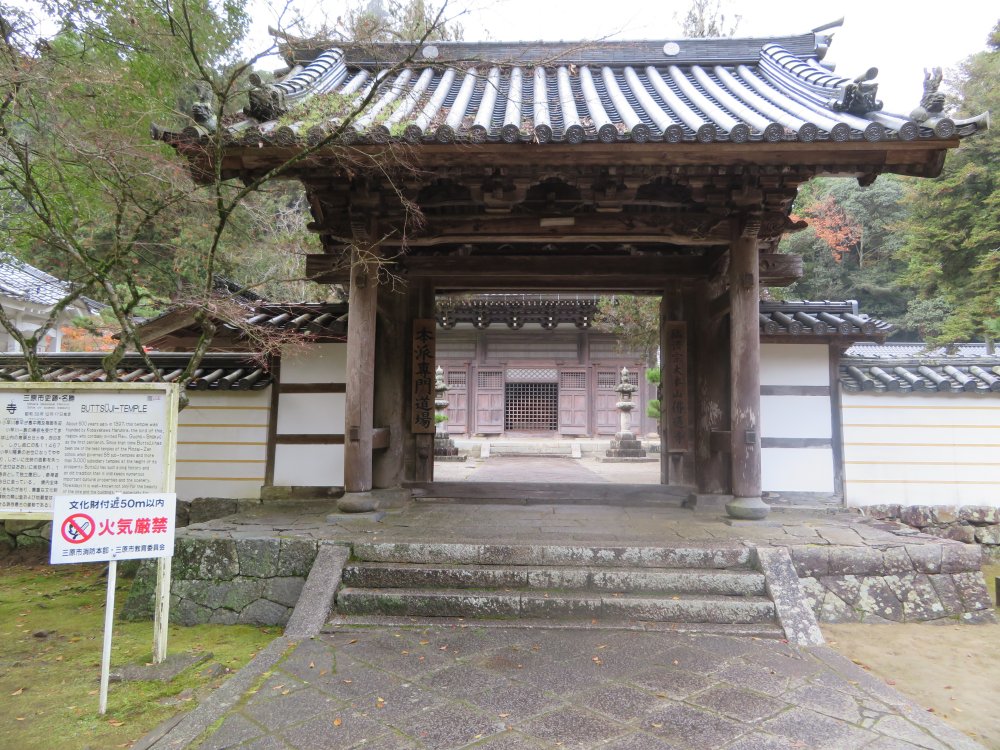
The sanmon gate of Buttsuuji Temple. I understand the gate was constructed at the end of the 18th century.
The main temple area was meticulously maintained and there was no one that we could see. I understand that the current main temple building was built in the early 19th century.
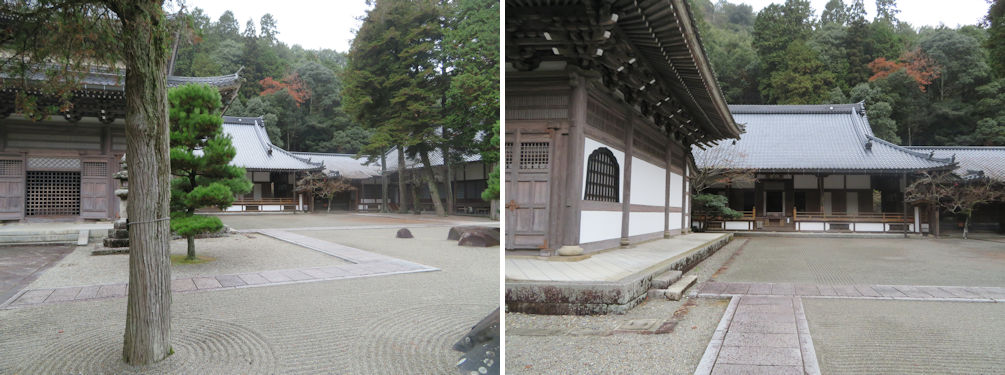
The meticulously maintained main temple area. There was noone in sight.
On our way back to the car park, we noticed the steps leading to the Kaizandou and Jizoudou, the oldest buildings of Buttsuuji. It was quite a long climb to reach the buildings. The description by the Jizoudou tells us that this building was built in 1406 shortly after the founding of Buttsuuji. The Kaizandou (meaning the foundation building) sits next to Jizoudou. I have no knowledge on when it was built, but the website of Buttsuuji writes that it was originally behind the Jizoudou and relocated to the current site in later years. Further up there is a bright pagoda called Tahoutou built in 1927. It was getting dark, and we left for Hiroshima Airport.
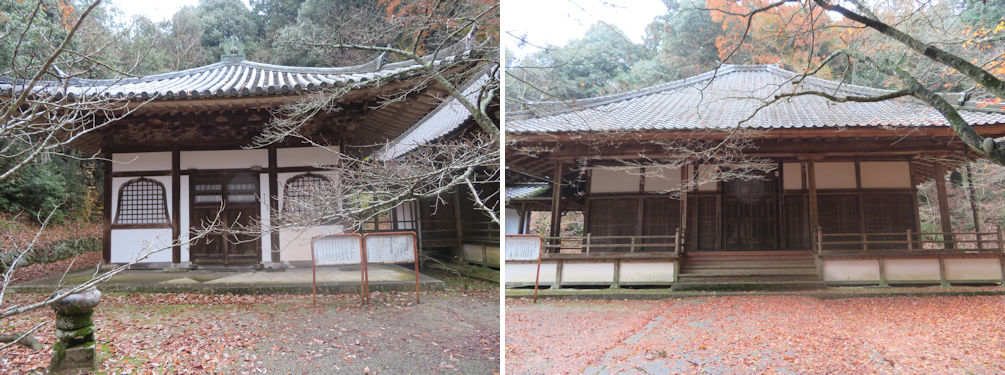
The Jizoudou built in 1406 is the oldest building in thetemple (left) and the Kaizandou (right).